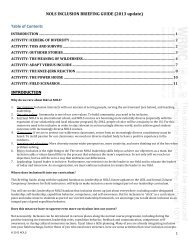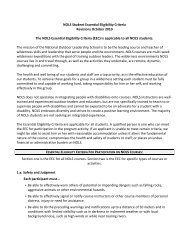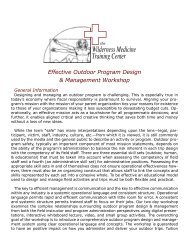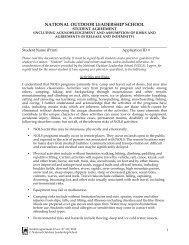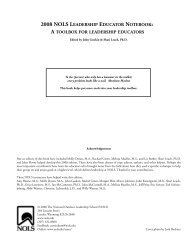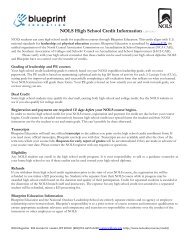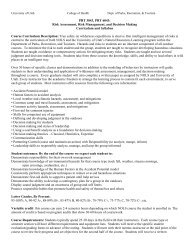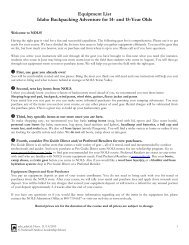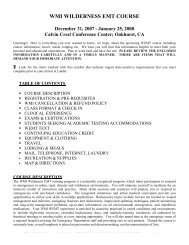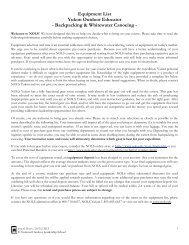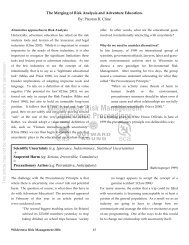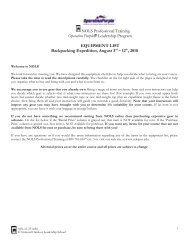to our world. - NOLS
to our world. - NOLS
to our world. - NOLS
You also want an ePaper? Increase the reach of your titles
YUMPU automatically turns print PDFs into web optimized ePapers that Google loves.
RISK MANAGEMENT AT <strong>NOLS</strong><br />
Ashley Wise<br />
Marco Johnson<br />
Betsy Wins<strong>to</strong>n<br />
Left: Hazard assessment is a key element of the <strong>NOLS</strong> curriculum. Wind River Range, Wyoming. Center: Instruc<strong>to</strong>rs clarify risk management pro<strong>to</strong>cols before engaging<br />
students in a new skill. Blue John Canyon, Dirty Devil, Utah. Right: Student <strong>to</strong> instruc<strong>to</strong>r ratios average 5 <strong>to</strong> 1 and vary according <strong>to</strong> skill being taught and student age.<br />
Northern Icefield, Patagonia<br />
At <strong>NOLS</strong> we embrace the physical and emotional challenge of the<br />
natural environment <strong>to</strong> attain <strong>our</strong> learning objectives. <strong>NOLS</strong> c<strong>our</strong>ses<br />
are not easy and involve the pursuit of adventurous activities in<br />
rugged terrain in which there are real dangers. Risk, both physical<br />
and emotional, is an important element of a <strong>NOLS</strong> education.<br />
The uncertainty posed by nature combined with the judgments and<br />
abilities of students and staff leads <strong>to</strong> risk. Risk management, in this<br />
context, is the ability <strong>to</strong> make a decision when the outcome is uncertain<br />
and relies on <strong>our</strong> ability <strong>to</strong> perceive and quantify the risks<br />
we face. Risk management is taught and practiced on every c<strong>our</strong>se.<br />
<strong>NOLS</strong> is committed <strong>to</strong> promoting the physical and emotional wellbeing<br />
of all students and we are proud of <strong>our</strong> excellent record managing<br />
the risks of wilderness travel.<br />
Wilderness adventure involves hazards: rockfall, fast-flowing rivers,<br />
and steep terrain can pose a risk <strong>to</strong> even the most experienced<br />
outdoor leader. Activities ranging from simple day hikes <strong>to</strong> climbing<br />
glaciers can, due <strong>to</strong> the unpredictable forces of nature or an error in<br />
judgment, become dangerous and potentially life-threatening.<br />
Students transport their own gear; sleep outdoors, possibly in<br />
co-ed tent groups; prepare their own meals; and are expected <strong>to</strong> care<br />
for themselves in weather conditions that can be extreme. Each student<br />
plays an important role in the success of a <strong>NOLS</strong> c<strong>our</strong>se. Good<br />
physical conditioning and a positive mental attitude are essential.<br />
Our c<strong>our</strong>ses are expeditions that travel through remote areas<br />
that can create complex situations should an emergency arise. The<br />
majority of medical incidents that might occur are simple and often<br />
treated in the field. A more serious incident, such as a fracture,<br />
will require evacuation <strong>to</strong> a medical facility. It is not uncommon<br />
<strong>to</strong> be days from medical help, but <strong>NOLS</strong> instruc<strong>to</strong>rs are trained in<br />
wilderness first aid and backed by comprehensive wilderness emergency<br />
response and evacuation systems.<br />
We carry satellite telephones, radios, or other electronic communication<br />
devices on each c<strong>our</strong>se for life threatening emergencies,<br />
but this does not guarantee communication from the field <strong>to</strong><br />
<strong>our</strong> support bases. Portable telephones and radios can be unreliable<br />
depending on terrain, atmospheric conditions, and other variables.<br />
It is important you understand that there are risks. Some adventure<br />
programs say that they can guarantee y<strong>our</strong> safety. <strong>NOLS</strong><br />
does not. The risk of injury, even serious injury or death, is always<br />
present in the outdoor environment. Indeed, much of the value of<br />
a <strong>NOLS</strong> c<strong>our</strong>se lies in learning how <strong>to</strong> identify hazards and adapt<br />
behavior <strong>to</strong> strive <strong>to</strong> avoid injury or illness.<br />
INDEPENDENT STUDENT TRAVEL<br />
On many c<strong>our</strong>ses, one of the ways we help you develop in<strong>to</strong> an<br />
outdoor leader is by giving you the opportunity <strong>to</strong> travel without<br />
instruc<strong>to</strong>rs. Our students say that this is a highlight of their c<strong>our</strong>se<br />
and one of the best ways that they learn <strong>to</strong> be leaders.<br />
By the second week, you will travel in student groups without<br />
instruc<strong>to</strong>rs for a day at a time. To prepare for this you’ll have<br />
classes and gain practical experience in backcountry travel while<br />
being coached by y<strong>our</strong> instruc<strong>to</strong>rs as they help you develop y<strong>our</strong><br />
leadership skills.<br />
If y<strong>our</strong> instruc<strong>to</strong>rs decide that y<strong>our</strong> group is ready, the culminating<br />
experience of many c<strong>our</strong>ses is the student expedition where,<br />
for several days, you and a few of y<strong>our</strong> c<strong>our</strong>semates will travel<br />
without an instruc<strong>to</strong>r. Y<strong>our</strong> instruc<strong>to</strong>rs help the c<strong>our</strong>se divide in<strong>to</strong><br />
groups, select a leader, and plan a route. You will know y<strong>our</strong> instruc<strong>to</strong>rs’<br />
route and campsites (no more than a day away), instruc<strong>to</strong>rs<br />
will carry a phone, and each student group will carry a satellite<br />
location transmitter or phone. You and y<strong>our</strong> group make the daily<br />
leadership decisions but still have all the benefits of <strong>NOLS</strong>’ support<br />
systems.<br />
LEADERS IN WILDERNESS EDUCATION<br />
When you come <strong>to</strong> <strong>NOLS</strong>, you will be attending the school that<br />
sets the standards in wilderness risk management, wilderness medicine,<br />
and student well-being. We have published one of the leading<br />
texts on wilderness medicine, and the Wilderness Medicine<br />
Institute of <strong>NOLS</strong> (WMI) is at the cutting edge of this growing<br />
field. We are the leaders in promoting professional standards in<br />
wilderness risk management and each year convene the Wilderness<br />
Risk Management Conference for outdoor educa<strong>to</strong>rs and adventure<br />
program administra<strong>to</strong>rs.<br />
Before you arrive on y<strong>our</strong> <strong>NOLS</strong> c<strong>our</strong>se, thoroughly read all<br />
materials we send you and call us if you have questions. A report<br />
on <strong>NOLS</strong> risk management and his<strong>to</strong>ry is available from <strong>our</strong> admission<br />
office.<br />
113




